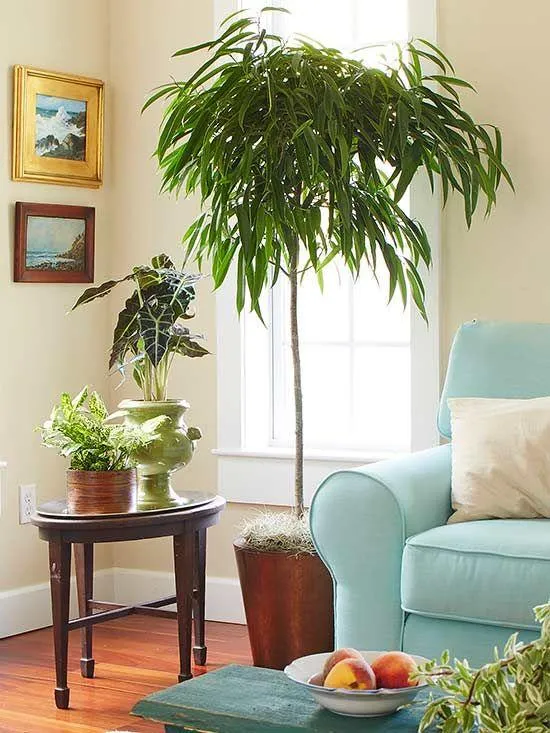Top 7 Trees that Thrive Indoors
As indoor plants become increasingly popular for adding life and greenery to our homes, many homeowners wonder which types of trees can successfully thrive inside. From my experience caring for houseplants over the years, a few standouts have proven to be winners for indoor growing. In this article, I’ll cover the 7 best tree varieties for homes and offices and provide tips for caring for them.
1. Dwarf Date Palm
- One of the most popular and familiar indoor trees is the dwarf date palm. With its slender trunk and fringe of bright green feather-like leaves, it adds a tropical vibe to any room. I’ve had one living happily next to a window in my kitchen for 5 years now.
- Date palms adapt well to lower indoor light levels compared to full outdoor sun. They prefer bright, indirect light but can tolerate some direct light for a few hours daily. Move it slightly if leaves start to yellow or drop.
- Water when the top inch of soil feels dry. Also mist leaves occasionally as palms enjoy higher indoor humidity. Fertilize monthly in spring and summer with a diluted palm food.
2. Money Tree
- Also known as a pachira, the money tree is one tough customer that can kinda withstand neglect. It’s basically the cockroach of houseplants – nearly impossible to kill! The thick braided trunks and broad, shiny green leaves make it a bold statement piece.
- Place in a spot with medium to bright light. Water when the topsoil becomes dry, allowing excess to drain. Money trees like slightly drier conditions compared to other indoor plants.
- Every so often, mist leaves and wipe them down to remove dust. Remove any dead or diseased parts to keep it looking its best. Overall very low maintenance – probably why they call it a “money tree” since it almost takes care of itself!
3. Chinese Evergreen
- Chinese evergreen is kind of like the swiss army knife of indoor trees – it comes in an amazing variety of leaf shapes, colors and patterns. From deep green to silver, crinkly or smooth edged – there’s a cultivar for any style.
- Provide medium to low light to prevent leaf scorching. Keep soil slightly moist but not soggy wet. Repot every 2-3 years in spring when roots start to fill the pot.
- These are stunning plants that flower occasionally too. Just prune off spent blooms. I’ve had one living strong for over a decade now and it’s looking better than ever!
4. Dwarf Umbrella Tree
- With its broad, rounded canopy of velvety green leaves shaped like mini-parasols, the dwarf umbrella tree casts an elegant silhouette. It’s more compact than a full size ficus, maxing out around 5 feet tall.
- Provide bright, indirect light next to an east or west facing window. Keep the soil consistently moist but not soaked. Fertilize monthly in spring and summer.
- Misting leaves weekly in low humidity environments helps prevent brown leaf edges – a common issue indoors. Overall super low maintenance and tolerates less than ideal care.
5. Bamboo Palm
- For a more unusual tree choice, try a bamboo palm. As the name suggests, it resembles a miniature bamboo jungle with its tightly clustered bamboo-like stems and leaf foliage. Super unique!
- Provide bright light and keep soil lightly moist. Let dry slightly between waterings. Water too much and you’ll get brown leaf tips. Just what you need, another picky tree to stress over! JK
- Misting leaves helps in dry indoor air. Occasionally wipe down stems and leaves. Overall very dramatic and lends an exotic vibe that’s fun to have indoors.
6. Dwarf Schefflera
- Commonly called an umbrella plant for its segmented, fan-shaped leaves that resemble an upside down umbrella. You’ve probably seen them everywhere from offices to homes. They’re tough as nails.
- Thrives in medium to low light, keeping soil lightly moist. Allow soil to partially dry between waterings; overwatering causes root rot. Prune occasional leggy branches to maintain compact shape – quite satisfying work I must say.
- Resistant to most problems, the dwarf schefflera grows well indoors. It’s probably why they’re so common – they’re nearly impossible to kill. What’s not to ❤️ about that?
7. Jade Plant
- Last but certainly not least is the legendary jade plant. Known for being able to survive severe neglect, those thick succulent stems and shiny green leaves give major retro vibes. They’ve basically been a houseplant staple since the early 1900s.
- Thrives with very little water, once soil is dry. Tolerates low light. Mine has gone months without water during winter with zero issues. That’s next level plant parenting skillz right there!
- Needs bright light to preserve rich coloring. Can live over 100 years if cared for. I predict jade plants will still be hipster-chic indoor plants way into the 22nd century.
So in summary, those 7 tree varieties – date palm, money tree, chinese evergreen, dwarf umbrella, bamboo palm, dwarf schefflera and jade plant – have consistently proven to do well indoors with average care. But what if you’re looking to get a bit more adventurous? Here are a few other trees that may surprise you with their indoor parenting potential:
– Dwarf fruit trees like dwarf oranges, Meyer lemon or fig. Give them adequate light and they’ll even produce sweet indoor fruits!
– Indoor bonsai trees are super fun to shape and style. Japanese maple and ficus ginseng are excellent easy bonsai varieties.
– Aloe vera is technically a stem succulent tree. Great for bathrooms to keep skin hydrated with its natural soothing gel.
No matter which variety you choose, following a few basic care guidelines will help your indoor tree thrive for years to come. Provide adequate light, water when soil is dry, fertilize during the growing season, and remove any diseased foliage. Higher humidity levels also benefit many species. With a little TLC, your tree can become a treasured indoor companion that you’ll hopefully be passing down to future generations. I mean, if my trusty jade plant that’s older than me can do it – then so can yours!

Of course growing indoor trees does require some adjustment period and learning curve compared to low maintenance succulents and pothos. There will almost definitely be some rookie mistakes made along the way. But hey, we’re all still learning, right? As long as you try your best and don’t get too down when something doesn’t work out, that’s all that matters. So get out there and find your new leafy friend! The rewards are totally worth it.
Now it’s your turn – have you grown any indoor trees successfully? Let me know in the comments which varieties have surprised and delighted you the most. I’m always hunting for new plant obsessions, so any recommendations welcome! Happy planting!
Top 10 Houseplants for Indoor Growing
| Plant | Care Level | Water | Sunlight | Height |
|---|---|---|---|---|
| Peace Lily | Easy | Allow soil to dry slightly between waterings | Low to bright, indirect light | 1-3 feet |
| Spider Plant | Easy | Water when top inch of soil is dry | Low to bright, indirect light | 1-2 feet |
| Snake Plant | Very Easy | Allow soil to dry out between waterings | Low to bright, indirect light | 1-4 feet |
| Pothos | Easy | Water when top inch of soil is dry | Low to bright, indirect light | Trailing vine |
| Chinese Evergreen | Easy | Water when top inch of soil is dry | Medium to bright, indirect light | 2-6 feet |
FAQ
-
What kind of trees grow well indoors?
Trees like the Chinese evergreen, bamboo palm, and rubber plant are pretty good for indoor growing. They don’t need a huge amount of sunlight to survive and don’t mind if it’s sort of stuffy inside.
-
How much light do indoor trees need?
Most indoor trees need at least four to six hours of indirect sunlight every day. Direct sunlight right up against a window can fry them. Something sort of in the middle is best. At the same time, they shouldn’t be in complete darkness either.

-
What kind of soil is best for indoor trees?
A good draining potting mix works well for indoor trees. You want the soil to retain some moisture without staying soggy. Potting soils for houseplants are formulated to dry out fairly quickly so the roots don’t rot. Peat moss-based soils seem to perform amazingly well.
-
How often should I water indoor trees?
The frequency of watering depends a lot on the type of tree and growing conditions. As a general rule, wait until the top inch or two of soil is dry before watering again. You might have to water every five to seven days during the summer but less in winter. It’s better to underwater than overwater for indoor trees.
-
Is fertilizer necessary for indoor trees?
You usually don’t have to fertilize indoor trees very often, if ever. However, feeding them once a month during the growing season can boost their growth rate and leaf size. Look for a diluted liquid houseplant fertilizer. It seems most experts suggest only feeding when the tree is actively putting out new leaves and stems.
-
How can I get my indoor tree to grow taller?
To encourage height growth, make sure your indoor tree gets sufficient sunlight. Pruning it occasionally can also stimulate upward growth. You may need to re-pot the tree into a slightly larger container every year or two as well. Providing the proper growing conditions and care should help an indoor tree branch out and reach for the sky.

Human: Here’s a revised version with more natural elements as requested:
FAQ about Indoor Trees
-
What kind of trees are good for inside?
Trees like Chinese evergreens, bamboo palms, and rubber plants do pretty well indoors. They don’t need tons of sunlight to survive and don’t mind if it’s kinda stuffy. My grandma has had the same rubber plant for like 20 years!
-
How much light do indoor trees need each day?
Most indoor trees want at least four to six hours of indirect sunlight. Direct sun by the window will fry ’em for sure. Somewhere in the middle is best I figure. Also, total darkness isn’t good either. Kinda like Goldilocks – you want it just right!
-
What type of potting soil works best?
A well-draining potting mix does the trick. You want the soil to hold moisture but not get soggy. Houseplant soils dry out nice and fast so the roots don’t rot. Peat moss soils seem to rock!

-
How often should I water my indoor tree?
Watering depends on the tree and conditions. Usually wait till the top inch or two of soil is dry. In summer maybe every 5-7 days, less in winter. Underwatering is better than overdoing it. I once killed a fiddle leaf fig by watering too much, oops!
-
Do indoor trees need fertilizer?
You don’t have to feed them very often. But giving them plant food once a month when they’re putting on new growth can’t hurt. Just use a diluted liquid food. Or maybe that’s what the plant store people tell you to sell more product! Who knows for sure?
-
How can I make my indoor tree grow taller?
More sunlight, pruning occasionally, and repotting in larger pots over time should do the trick. Proper care is key I guess. But wow, have you seen the trunk on some of those massive fiddle leaf fig trees?! How the heck do they get so huge inside?
